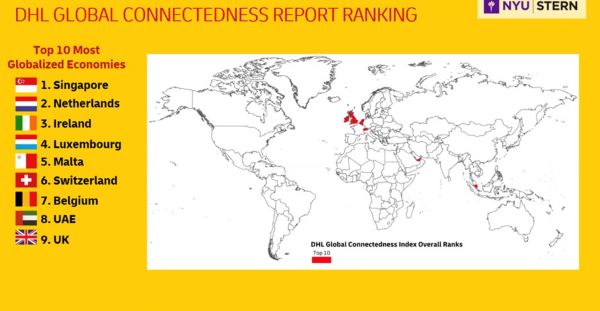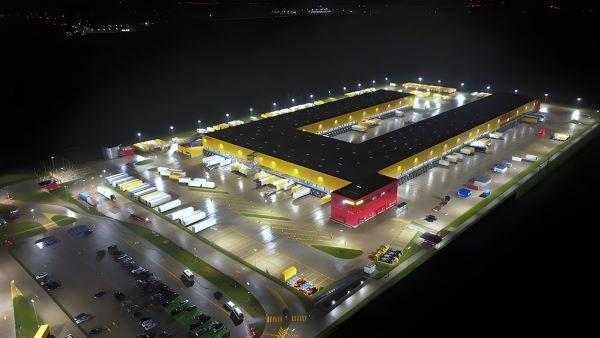The Capitals of Connection
|

“Singapore has invested heavily in strengthening our physical and digital connectivity to the world because trade is our lifeblood,” said Ih-Ming Chan, executive vice president, Singapore Economic Development Board.
Photo of Henderson Waves pedestrian bridge courtesy of Singapore Tourism Information & Services Hub
|
|
This year, for the first time, among the external indices used in Site Selection’s Global Best to Invest rankings (due to be released on Thursday, May 1) is the DHL Global Connectedness Report. Released in March by DHL and New York University’s Stern School of Business, the annual report tracks how flows of trade, capital, information, and people move around the world and measures the globalization of 181 countries and territories.
“The world is at a record high level of globalization despite geopolitical conflict and policy headwinds,” said Steven Altman at a March 2024 press conference announcing the results. Altman is senior research scholar and director of the DHL Initiative on Globalization at NYU Stern’s Center for the Future of Management. “Deglobalization is still only a risk, not a current reality,” he wrote in the new report. “Geopolitical threats and public policy shifts have led many to predict a fracturing of the world economy along geographic or geopolitical lines, or even a retreat from international to domestic business. But the latest data still show that international flows are growing and very few countries are cutting ties with their traditional counterparts. It is important to recognize the resilience of global flows because a lopsided focus on the threats to globalization could make deglobalization a self-fulfilling prophecy.”
That said, on a scale of 0% to 100% (no flows across national borders to “borders and distanced have ceased to matter at all”), the world stands at only 25% globalization, the report’s authors Altman and Caroline R. Bastian found, allowing ample room for more ties to be created and more capital, people, information and goods to flow.
“Expanding markets and fostering opportunities empower individuals, businesses, and entire nations to flourish in unique ways.”— John Pearson, CEO DHL Express
How are trade and military conflicts impacting connectedness? The data say the ties between China and the U.S. have decreased by one-quarter since 2016. The United States is currently ranked No. 44 overall, while China ranks No. 80. Nevertheless, said Altman, the two countries “are still connected by a larger share of flows than almost any pair of countries in the world. The only two with stronger ties are the U.S. and the UK,” a country whose connectedness ranking has hovered between No. 9 and No. 10 for most of the past two decades, Brexit or no Brexit.
Among the world’s 10 largest economies, both China and the U.S. saw their connectedness ranks drop by 10 positions from 2017 to 2022, while Germany and India rose by one position and Italy rose by three positions to No. 36. As for Russia, its rank has plummeted to No. 91 from as high as No. 58 in 2016.
|
|
‘Trade Is Our Lifeblood’
Small countries and city-states that function as key linchpins of commerce and trade top the rankings: Singapore is No. 1, followed by The Netherlands and Ireland. Overall, 143 countries became more globally connected and 38 saw their levels of connectedness decline. “Further evidence shows that Europe is the world’s most globally connected region,” the report stated. Mike Parra, CEO of DHL Express Europe, observed that one of the company’s fastest-growing e-commerce customers is an end-of-the-runway customer at the DHL hub in Leipzig. “What I have seen, and we’re seeing more and more, is Germany as a destination is one of the biggest trading partners in the EU for us, with the end destination in Germany. I don’t happen to believe it’s because our global office is in Germany. It’s demand, the connectedness and stickiness Germany has. I see Germany as a real big opportunity for us.”
As for the world leader in connectedness, “Singapore has invested heavily in strengthening our physical and digital connectivity to the world because trade is our lifeblood,” said Ih-Ming Chan, executive vice president, Singapore Economic Development Board. “We continue to enhance our connectivity and trade links to remain a critical and trusted node in global supply chains, facilitating international trade and flows of capital, information and talent. We look forward to partnering with global companies seeking a launchpad for business growth and supply chain expansion in Asia-Pacific and beyond.”

The overall report analyzes nearly 9 million data points that cover 99.7% of the world’s GDP and 98.7% of its population. Running a comb through some of the data points reveals a few further findings:
- From 2001 through 2022, Singapore has been No. 1 every year but 2006 and 2015, when Luxembourg achieved that rank. Luxembourg this year is No. 4.
- Among the most dramatic upward movers has been the United Arab Emirates, which was No. 26 in 2001 and has risen to No. 8 this year. This finding is corroborated by the more recently released FDI Confidence Index from Kearney, which finds that the UAE over a year’s time went from No. 18 to No. 8. “The United Arab Emirates has been steadily introducing significant business and legal reforms in recent years that relax pre-existing rules dictating the degree to which foreign investors can invest in onshore companies,” the Kearney report found. “Additionally, Oxford Economics expects robust GDP growth of 4.4% for the UAE in 2024, citing strong performance of non-oil sectors.”
- Which nations lead across the four categories of trade, capital, information and people flows? Here are the top five in each category:
Trade
- Singapore
- Netherlands
- Belgium
- UAE
- Ireland
Capital
- Singapore
- Luxembourg
- Hong Kong SAR, China
- Malta
- Ireland
Information
- Netherlands (No. 1 since 2004)
- United Kingdom
- Ireland
- Singapore
- Sweden
People
- Luxembourg
- United Kingdom
- Malta
- Switzerland
- UAE
|

In addition to major hubs like this one in Leipzig, DHL itself has contributed to trade infrastructure with gateway expansions in Lyon, Barcelona and Helsinki and the opening of a new hub in Copenhagen.
Photo courtesy of DHL
|
|
I asked Mike Parra and report co-author Altman about further indicators in the area of people flow, i.e. the transfer or migration of talent. Parra said internally he’s seen more talent transfer from the UK to the rest of Europe than he’s seen in countries like Poland or Ireland, where DHL team members have long tenures. Trends vary by country and by culture, he said, but people by and large are “happy to stay within their own countries.”
Altman said overall migration has accelerated, with OECD member country immigration and individual countries such as Canada and the UK hitting records in 2022. One compelling finding, he said, was that “migration based on intra-company transfer is still below 2019 levels. It looks like the pandemic may have had a lasting effect on the ways companies move people around the world.
“Migration is a great illustration of the value of putting numbers to globalization,” Altman continued. “Of all the people around the world, 3.6% live outside the countries where they were born. When we asked them, they think it’s 30%. People think there are far more people that have migrated than there actually are. Ask about their own countries and they think there are twice as many immigrants as there actually are.”
Parra also spoke to how DHL’s fundamental mission helps attract and keep talent, referring to the company’s “wheel of purpose” at the core of its mission.
“The value we deliver to society is at the very center of our approach to leadership,” he said, within the company and within the marketplace. “It’s important to emphasize that trade itself has a social value. It contributes to economic development, lifts people out of poverty and delivers supplies to people who need them.” The company’s broader commitment to people is captured in the work of its disaster response team and its educational initiatives, he said.
“This is how we make a difference,” Parra said. “It’s one of the main things I emphasize and a powerful recruitment tool for an industry like ours with global trade at its core.” — Adam Bruns
|

DHL itself continues to contribute to global connectedness with facility expansions like this new International Logistics Center that opened in February in Poznan, Poland, a country where FDI inflow increased from $19 billion in 2019 to nearly $37 billion in 2022.
Photo courtesy of DHL
|
|
|

